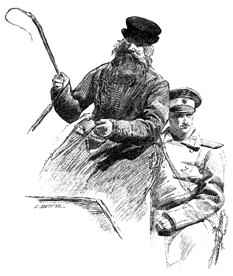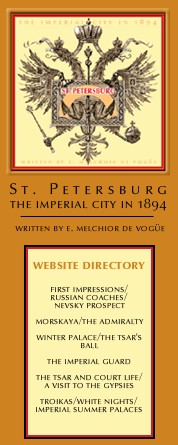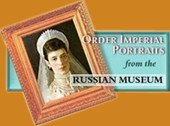FIRST IMPRESSIONS - RUSSIAN COACHES - NEVSKY PROSPECT
THEOPHILE GAUTIER thinks that every country should be visited in its most characteristic season-Spain when it is broiling hot beneath the burning sun; Russia when it is wrapt in its shroud of snow. This opinion is open to discussion with regard to the provinces of Russia, which present one dreary monotony from the Black Sea to the Arctic Ocean. But, as far as St. Petersburg is concerned, Gautier's aphorism needs no contradiction, for it is a jewel, the whole value of which is not seen except when it is set in its rim of dull silver. Empty and lifeless in the summer, the town wakes to life with the first snows, when sledging makes traffic easy, and the ice has made bridges unnecessary, the Neva and its canals being for six months one solid mass of ice. In the streets, the shops, and the drawing-rooms of St. Petersburg men of every degree are roused to fresh activity just when, in the natural course of things, they would sink into torpor. Life seems to increase in activity as a direct result of the rigors of the climate.
From the German frontier the traveller has rolled over one monotonous undulating plain, between marshes and pine forests, with here and there a lonely poverty-stricken village, with low thatched houses breaking the long white lines with a black patch. Nothing else meets the weary eye; on every side is a lifeless country, without light, without form or color, beneath a dull leaden sky that oppresses the soul with a feeling of gloom. Not until the last moment is there anything in these vast solitary districts to warn the traveller of his approach to the capital. All of a sudden, before the train, as it flings aside the snow, rises the Palmyra of the North, with its golden cupola - as and gleaming churches.
 Beneath the light of a pale copper colored sun, which is above the horizon but for a few hours a day, we get into sledges and glide rapidly over the hard snow carpet in the streets. We pass first through the industrial quarters, between lofty houses with hermetically sealed double windows. These wide suburbs are not particularly clean, and we might fancy ourselves still in Berlin but for the type of artisans we see going. in and out of the shops in their sheepskin garments. Our equipage crosses the three concentric canals connected with the Neva, which Peter the Great had made when he was fresh from Amsterdam. He wanted his new capital to rival that of Holland, and he built it, as Amsterdam was built, upon a forest of piles in the midst of the marshes of Finland, where he wished to concentrate the commerce of the North. Here we are in the heart of the city, in the Nevsky Prospect, or Neva Perspective, the great Triumphal Road, which takes its name from the monastery from which it starts, the Lavra of St. Alexander Nevsky, which is a sanctuary consecrated to relics of heroes of Russia, and the burial-place of the chief families. From this point the Perspective extends for three miles, as far as the buildings of the Admiralty, which intercept the view of the river. All the way along, the thoroughfare presents a most animated and characteristic scene. The horses dash along, crossing each other like flashes of lightning, and sprinkling with the powdered snow from their steel shoes the occupants of the long, narrow sledges called egotists, which have no backs, and in which one sees now an officer, now some young girl balancing the body in a crouching position with the knees imprisoned beneath a bear's skin. When two drive together in a sledge, the gentleman holds the lady in her place in a chivalrous manner by passing his right arm lightly round her waist. On the tiny little coach-box sits a huge driver with a long beard in a vast great coat, and wearing a square red or blue velvet cap. fie guides his trotting horse with the majestic air of a pope, his arms rounded, his elbows sticking out, and the reins, which are as thin as mere threads, held tightly in his hands. The harness, which is made of a few strips of leather, is scarcely visible, and this gives a wonderful look of elegance to the steed, which seems to run without any restraint beneath the donga, as the great arched piece of wood above the collar is called. Sometimes a second horse, called a "fool" * (that is to say, a leader), is used, harnessed to the first by a single strap, and this second steed frisks and gambols about like a mad thing, When a third horse is harnessed, the carriage is known as a troika; this is the classic equipage, in which the horse harnessed to the sledge trots between his two galloping companions. On either side of the road more humble vehicles ply for hire, such as sledges drawn by thick-set cart-horses, driven by rough-coated peasants-tillers of the soil, who have flocked in from the neighboring districts to earn a little money in the capital in the winter.
Beneath the light of a pale copper colored sun, which is above the horizon but for a few hours a day, we get into sledges and glide rapidly over the hard snow carpet in the streets. We pass first through the industrial quarters, between lofty houses with hermetically sealed double windows. These wide suburbs are not particularly clean, and we might fancy ourselves still in Berlin but for the type of artisans we see going. in and out of the shops in their sheepskin garments. Our equipage crosses the three concentric canals connected with the Neva, which Peter the Great had made when he was fresh from Amsterdam. He wanted his new capital to rival that of Holland, and he built it, as Amsterdam was built, upon a forest of piles in the midst of the marshes of Finland, where he wished to concentrate the commerce of the North. Here we are in the heart of the city, in the Nevsky Prospect, or Neva Perspective, the great Triumphal Road, which takes its name from the monastery from which it starts, the Lavra of St. Alexander Nevsky, which is a sanctuary consecrated to relics of heroes of Russia, and the burial-place of the chief families. From this point the Perspective extends for three miles, as far as the buildings of the Admiralty, which intercept the view of the river. All the way along, the thoroughfare presents a most animated and characteristic scene. The horses dash along, crossing each other like flashes of lightning, and sprinkling with the powdered snow from their steel shoes the occupants of the long, narrow sledges called egotists, which have no backs, and in which one sees now an officer, now some young girl balancing the body in a crouching position with the knees imprisoned beneath a bear's skin. When two drive together in a sledge, the gentleman holds the lady in her place in a chivalrous manner by passing his right arm lightly round her waist. On the tiny little coach-box sits a huge driver with a long beard in a vast great coat, and wearing a square red or blue velvet cap. fie guides his trotting horse with the majestic air of a pope, his arms rounded, his elbows sticking out, and the reins, which are as thin as mere threads, held tightly in his hands. The harness, which is made of a few strips of leather, is scarcely visible, and this gives a wonderful look of elegance to the steed, which seems to run without any restraint beneath the donga, as the great arched piece of wood above the collar is called. Sometimes a second horse, called a "fool" * (that is to say, a leader), is used, harnessed to the first by a single strap, and this second steed frisks and gambols about like a mad thing, When a third horse is harnessed, the carriage is known as a troika; this is the classic equipage, in which the horse harnessed to the sledge trots between his two galloping companions. On either side of the road more humble vehicles ply for hire, such as sledges drawn by thick-set cart-horses, driven by rough-coated peasants-tillers of the soil, who have flocked in from the neighboring districts to earn a little money in the capital in the winter.
1.) * This fool is a horse harnessed by traces, who canters alongside of the trotter in the shafts.
Following the Perspective from the Lavra to the Neva, one passes on the left the little Anichkov Palace, where the Emperor Alexander III. resides when ceremonies do not claim his presence at the Winter Palace; the Imperial Library, formed at immense expense by Catherine, which boasts the manuscripts of Diderot, the archives of the Bastille, the library of Voltaire, and the celebrated statue of that French philosopher reproduced by Houdon for the lobby of the Comédie Francaise. A little farther on rises from the centre of a square Notre Dame de Kazan, with a colonnade in imitation of that of St. Peter's, Rome; except the cathedral of St. Issac's, the largest and most richly decorated church of St. Petersburg containing on the marble facings of its walls numerous flags, the spoils of the French Grande Armee, while the baton of the Maréchal de Davoust is fastened to a pillar opposite the High Altar.







